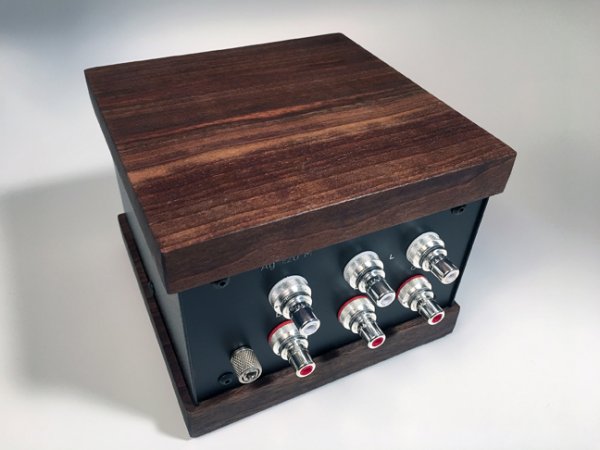
What is an LR Phono Corrector? It's a phono preamp where the RIAA equalization circuit is completely capacitor-free, only inductors and resistors. According to EMIA's LR Phono Corrector ("LRPC") web page, "the inside of our chassis contains the best parts in the industry… 80% nickel output transformers housed in non-magnetic brass end bells… mu-metal shielded internal black boxes encasing four 80% nickel inductors used in our capacitor-free RIAA equalization circuit... Teflon sockets... nickel power supply chokes... silver jacks… you know, the good stuff..."
This 2 box affair has a power stage (heavier than you might think) and a head stage (the LR corrector). A hearty power umbilical cord connects the two units which allows the power supply to be distanced (about 6') from sensitive electronics. In my system, the power supply was equally quiet immediately adjacent to the head-unit (aka it's quiet). Mechanically, the power supply is quiet and the head unit is an absolute rock (no sound at all). Inside the head unit, the smart use of a PCB topped with tubes, inductors and resistors is evidence of no-frills, meat-on-the-bones approach to design and component selection. Standard RCA jacks are silver. Two versions of EMIA's LRPC are available: copper windings at $15,000 or optional .9999 silver windings at $27,000.
EMIA's LRPC has a MM input. So, you must either have an MM cartridge or an MC step-up transformer. EMIA makes their own MC step-up transformers. With this review, I am using both an MM cartridge (Signet TK7USE) and Murasakino's state-of-the-art Sumile cartridge and Nobala MC step-up combo. EMIA wisely added an "load" RCA jack that connects in parallel with the input RCA jacks. This facilitates unlimited cartridge loading options, just solder your favorite resistor to the + and - terminals on an RCA connector, then plug into the RCA jack into the EMIA. Done.
For a frame of reference, this unit is being compared to my historical reference phono stages (Boulder 2008, Lyra Connoisseur and EMT JPA-66). One could argue that these 3 phono stages would occupy the top 5 in the world. So, how does EMIA's LRPC compare? 80% nickel inductors have a natural, true-to-life presence that, in my opinion, is unbeatable. Since the LRPC is early in the system chain, the 80% nickel inductors, resistors and no capacitors really makes it's presence known. It just sounds correct. Whereas the Boulder and EMT were possibly more "accurate" and extended top-end, the EMIA sounds more organic and natural. Again: lifelike, meaty, fast, nimble, yet a heavy weight champion. Of the 4 phono stages being compared, The Lyra Connoisseur (LCR design) had transparency, accuracy and a relaxed presentation. The Lyra lacked the heavy weight drive and (to borrow from the vinyl fanatics) PRAT. The sound of nickel is hard to describe. But, to these ear, EMIA's nickel implementation is more pleasing and easy to listen to for long periods. Bass if full, thrusting and not bloated. EMIA's high end appears to be natural, not etchy, edgy or exaggerated. The Boulder could be edgy at times. The EMT is probably the most non-invasive of the 4 phono stages, but EMIA has a special naturalness. Mid-range, especially the lower mid-range, is where the LRPC is a champion. It appears that the nickel inductors have extra drive and weight compared to other phono stages. Maybe this is where the EMIA gets its gestalt, in the lower midrange.
My preferred music genre is classical chamber (late 20th and 21st century). Think strings, strings and more strings. With late 20th and 21st century chamber music, the 12 tone structure, minimalist and modernist compositions do not rely upon harmonized mass strings. Rather, quite frequently just the opposite. Pizzicato, squeaky violin techniques, pianissimo and forte extremes dot the musical landscape. The Boulder and Lyra's transparency could make this genre of music unlistenable for extended listening sessions. The EMT would have a less extreme approach to transparency (likely because of the 3 x 12AX7 tubes per channel) and becomes more listenable with plenty of drive and dynamics. The EMIA, just lets the music flow without any added glare, highlighting or over punctuation. Once again, lifelike. EMIA LRPC uses 1 input and output tube per channel, specifics available in the manual on their website: http://myemia.com/LR.html . The combination of nickel and tubes has unrivaled, faithful tonality with strings.
Someday I might flash the cash for EMIA's silver windings, but for now, I am perfectly satisfied with the copper sister unit. For the foreseeable future, the EMIA is it. No other phono stage (nor line stage when compared with the EMIA Elmaformer) is tempting at this point. For $15,000 USD, the EMIA LR Phono Corrector is a steal and in my opinion sits a-top the phono stage ladder.
Last edited by a moderator:


